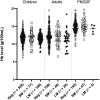Burden of Submicroscopic Plasmodium Infections and Detection of kelch13 Mutant Parasites in Military and Civilian Populations in Papua New Guinea
- PMID: 38377613
- PMCID: PMC10993850
- DOI: 10.4269/ajtmh.23-0508
Burden of Submicroscopic Plasmodium Infections and Detection of kelch13 Mutant Parasites in Military and Civilian Populations in Papua New Guinea
Abstract
Malaria remains a major public health problem in Papua New Guinea (PNG) and an important force health protection issue for both PNG and Australian Defence Forces. To investigate the malaria burden in the military and civilians residing on military bases, a cross-sectional survey was conducted in April 2019 at three military bases in Wewak, Manus Island, and Vanimo, PNG. A total of 1,041 participants were enrolled; 235 military personnel from three bases and 806 civilians from Wewak and Vanimo. Polymerase chain reaction (PCR) revealed an overall high prevalence of Plasmodium infection in both the military and civilians. Among the military, the infection prevalence was significantly higher in Wewak (35.5%) and Vanimo (33.3%) bases than on Manus Island (11.8%). Among civilians, children (<16 years old) had significantly higher odds of being PCR positive than adults (≥16 years old). At Wewak and Vanimo, Plasmodium vivax accounted for 85.4%, 78.2%, and 66.2% of infections in military, children, and adult populations. Overall, 87.3%, 41.3%, and 61.3% of Plasmodium infections in the military, children, and adults, respectively, were detected only by PCR, not by microscopy (submicroscopic [SM] infections). Children had a significantly lower proportion of SM infections than adults and Papua New Guinea Defence Force personnel. Infection status was not associated with hemoglobin levels in these populations at the time of the survey. Mutant kelch13 (C580Y) parasites were identified in 5/68 Plasmodium falciparum-infected individuals. The survey results indicate extensive malaria transmission on these bases, especially in Wewak and Vanimo. More intensified interventions are required to reduce malaria transmission on PNG military bases.
Conflict of interest statement
Disclosure: The views expressed in this article are those of the authors and do not necessarily reflect the official policy or position of the Department of Defence, Australia and the PNG Defence Force. Ethical approvals for the conduct of the survey and laboratory tests were granted by the Departments of Defence and Veterans’ Affairs Human Research Ethics Committee (DDVA HREC 084-18) and the Medical Research Advisory Committee of PNG (MRAC No: 18.21).
Figures







Similar articles
-
A Health Survey Revealing Prevalence of Vector-Borne Diseases and Tuberculosis in Papua New Guinea Defence Force Personnel and Families.Am J Trop Med Hyg. 2023 Sep 25;109(5):1086-1094. doi: 10.4269/ajtmh.23-0341. Print 2023 Nov 1. Am J Trop Med Hyg. 2023. PMID: 37748766 Free PMC article.
-
The epidemiology of Plasmodium falciparum and Plasmodium vivax in East Sepik Province, Papua New Guinea, pre- and post-implementation of national malaria control efforts.Malar J. 2020 Jun 5;19(1):198. doi: 10.1186/s12936-020-03265-x. Malar J. 2020. PMID: 32503607 Free PMC article.
-
Sustained Malaria Control Over an 8-Year Period in Papua New Guinea: The Challenge of Low-Density Asymptomatic Plasmodium Infections.J Infect Dis. 2017 Dec 12;216(11):1434-1443. doi: 10.1093/infdis/jix507. J Infect Dis. 2017. PMID: 29029179 Free PMC article.
-
Vaccines against malaria: perspectives from Papua New Guinea.Hum Vaccin. 2010 Jan;6(1):17-20. doi: 10.4161/hv.6.1.10332. Epub 2010 Jan 15. Hum Vaccin. 2010. PMID: 20173407 Review.
-
Out of Africa: origins and evolution of the human malaria parasites Plasmodium falciparum and Plasmodium vivax.Int J Parasitol. 2017 Feb;47(2-3):87-97. doi: 10.1016/j.ijpara.2016.05.008. Epub 2016 Jul 2. Int J Parasitol. 2017. PMID: 27381764 Free PMC article. Review.
References
-
- Müller I, Bockarie M, Alpers M, Smith T, 2003. The epidemiology of malaria in Papua New Guinea. Trends Parasitol 19: 253–259. - PubMed
-
- Betuela I, Maraga S, Hetzel MW, Tandrapah T, Sie A, Yala S, Kundi J, Siba P, Reeder JC, Mueller I, 2012. Epidemiology of malaria in the Papua New Guinean highlands. Trop Med Int Health 17: 1181–1191. - PubMed
-
- Ford E, 1950. The malaria problem in Australia and the Australian Pacific territories. Med J Aust 1: 749–760. - PubMed
-
- Black RH, 1956. The epidemiology of malaria in the southwest Pacific: changes associated with increasing European contact. Oceania 27: 136–142.
-
- Peters W, Standfast H, 1957. Report on a malaria survey in the Sepik district. Med J Aust 44: 861–868. - PubMed
MeSH terms
LinkOut - more resources
Full Text Sources
Medical
Miscellaneous

